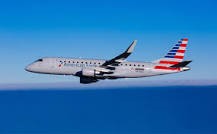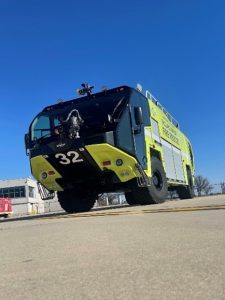Letter from the Executive Director – Dec. 2022
Our airport is excited to welcome new, larger jets, starting this month. American Airlines’ regional affiliate, Envoy, now operates both daily roundtrips to and from Dallas/Ft. Worth with 76-seat Embraer ERJ175 aircraft. The planes are much larger than the 50-seaters previously used on the route, and they feature 12 first class seats – the first time American has offered a first class product in Champaign-Urbana. The plane also has larger overhead bins, which means you won’t have to gate-check your roll aboard.
The shift to larger planes adds about 25% more daily departing seats, which could help to lower fares, and will ensure you have more travel options. American is also flying a third daily departure to Chicago O’Hare for the holiday season, to keep up with resilient demand in our market.
Our travelers are filling more seats at Willard Airport than at any time in history. This summer, 91% of all seats went out full – among the highest share of any airport in the Midwest. We know Willard can support more airline capacity.
To that end, we have spent the fall meeting, in person, with a number of airlines to ensure they understand the market dynamics. We meet not only with “network carriers” like American, but also many low-cost airlines that could connect east central Illinois to vacation destinations such as Florida and Las Vegas.
The current challenge for all carriers is a lack of pilots. More than 4,000 pilots retired during the pandemic, and there simply aren’t enough fully qualified pilots available to fill those positions.
Parkland College, a tenant at Willard, is working to train the next generation of pilots – with 100 future aviators currently enrolled. But it will be several years before those students are ready to fly passengers.
Until then, we will continue to make the case that our market is the best place for airlines to allocate aircraft and pilot time. And, as you’ll read in this newsletter, the federal Department of Transportation also believes in Champaign-Urbana with an $850,000 grant award to help us recruit service to Washington, DC.
In the meantime, we appreciate when you Fly Champaign-Urbana first.
Tim Bannon, A.A.E.
Executive Director
University of Illinois – Willard Airport
Click here to read the full newsletter

 Willard Airport leadership frequently meets with American, working to secure more capacity and to better serve the region. The Airport built a business case for American to replace 50-seat regional jets with larger planes. American agreed that the market can support the additional seats.
Willard Airport leadership frequently meets with American, working to secure more capacity and to better serve the region. The Airport built a business case for American to replace 50-seat regional jets with larger planes. American agreed that the market can support the additional seats. The new planes are much larger, with 2-by-2 seating in economy and 1-by-2 seating in American’s first class. Each plane is configured with 12 first class seats and 64 seats in economy. The planes have much larger overhead bins, allowing you to stow your roll aboard in the bin above your seat, instead of having to gate check your bag and wait for it when you arrive.
The new planes are much larger, with 2-by-2 seating in economy and 1-by-2 seating in American’s first class. Each plane is configured with 12 first class seats and 64 seats in economy. The planes have much larger overhead bins, allowing you to stow your roll aboard in the bin above your seat, instead of having to gate check your bag and wait for it when you arrive. As Car and Driver writes, “Think of the Striker as the Porsche 959 of firetrucks. The Striker offers a 30-degree angle of approach and departure, and it can climb a 50-percent grade. It’s designed to flatten the standard chain-link fences that surround U.S. airports. It’s 10 feet wide-with a monster track that helps keep it upright even when it’s leaning 30 degrees to port or starboard.”
As Car and Driver writes, “Think of the Striker as the Porsche 959 of firetrucks. The Striker offers a 30-degree angle of approach and departure, and it can climb a 50-percent grade. It’s designed to flatten the standard chain-link fences that surround U.S. airports. It’s 10 feet wide-with a monster track that helps keep it upright even when it’s leaning 30 degrees to port or starboard.” Andrew Smith, C.M., A.C.E, joined Willard Airport in August 2022 as the Assistant Director of Operations and Maintenance. Originally from New York, Andrew has more than ten years of airport experience. He’s previously worked in parking and terminal services, FBO line service, and Airport Operations.
Andrew Smith, C.M., A.C.E, joined Willard Airport in August 2022 as the Assistant Director of Operations and Maintenance. Originally from New York, Andrew has more than ten years of airport experience. He’s previously worked in parking and terminal services, FBO line service, and Airport Operations.